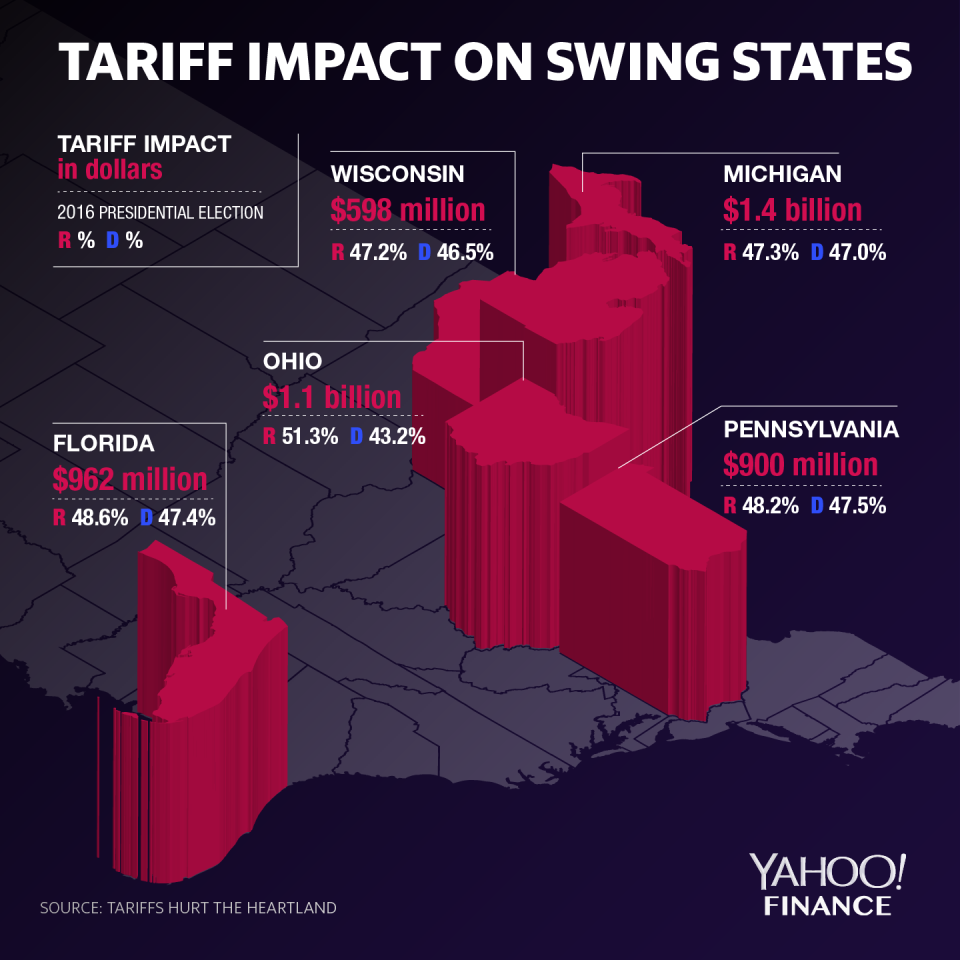How Trump's tariffs are hurting swing states
President Trump’s bid for reelection in 2020 means that he can’t afford to lose in key swing states such as Ohio, Wisconsin, Pennsylvania, Florida, and Michigan – states he carried in 2016. The states that are important in 2020 just happen to also be getting hit hard by the trade war in every sector of their economy.
“States like Michigan, Wisconsin, Pennsylvania – they are agriculture states, but they are also retail states and they have a lot of small businesses, and they also have major manufacturers,” says Matt McAlvanah, spokesman for Tariffs Hurt the Heartland, an alliance of more than 150 associations representing various sectors of the economy. “What we’ve seen is that those states are being hit hard and there isn’t any sector of their economy that has been spared.”
Trump’s decision to launch multiple wars with U.S. trading partners including China, the EU, and Mexico has resulted in roughly $4.9 billion in additional tariff costs so far for these key swing states, according to Tariffs Hurt the Heartland.
The ongoing trade battle with China stands out as being particularly painful for farmers and businesses – not to mention consumers.
U.S. soybean exports to China plunged 82% from August 2018 to March 2019 compared to a year earlier, after China imposed 25% tariffs on U.S. goods in retaliation for Trump’s round of tariffs in 2018.
“The trade war has had enormous costs. We understand that China has been a bad actor, but that exports of farmers and increasing prices for small businesses, should have nothing to do with addressing China’s trade abuses,” says McAlvanah.
According to a note from JPMorgan published last month, tariffs are expected to cost American households up to $1,000 a year as the latest round took effect this month.
Naturally, businesses and farmers would prefer a strategy that doesn’t penalize them. Trump has shown no signs of backing down as two new rounds of tariffs are set to hit Chinese imports on Oct. 15 and Dec. 15. Democratic candidates, on the other hand, have failed to articulate a better way. “Both Democrats and Republicans should be a part of the campaign, providing ideas for how to hold China accountable without making Americans collateral damage,” McAlvanah says.

McAlvanah faults Congress for being absent in the discussion. “There needs to be a way for Congress to play some sort of oversight role in how tariffs are used. And that’s not something that Congress has been talking about. Congress has not had a role in oversight over how the president uses tariffs,” he says.
Here’s a deeper look at how tariffs have been hurting key swing states, according to recent data by Tariffs Hurt the Heartland.
Florida
Tariffs have cost Florida farmers, businesses, and taxpayers $962 million so far, including $117 million in July. The state’s exports of goods subject to retaliation, including boats, have dropped 46% year-to-date as a result of the $241 million in retaliatory tariffs Florida businesses
Ohio
Ohio taxpayers have paid $1.1 billion in additional Trump tariffs so far, and $121 million in July. Exports of goods subject to retaliation including gear boxes have fallen 20% year-to-date as the state’s farmers and businesses have faced $599 million in new retaliatory tariffs.
Michigan
Michigan has paid $1.4 billion in tariffs, including $129 million in July. Exports of goods subject to retaliation, including steel pipes, have dropped 6.6% year-to-date as the state’s businesses have faced $561 million in retaliatory tariffs.
Wisconsin
Wisconsin taxpayers have paid $598 million, including $65 million in July. Exports of products subject to retaliation, including toilet paper and napkins, have dropped 20% year-to-date as the state’s businesses have faced $250 million in retaliatory tariffs.
“When it comes to agriculture, a state like Wisconsin has had more foreclosures mainly in dairy farms over the past year than any other state in the country. That is an iconic commodity within that state and what you’re seeing is that tariffs are having a huge negative impact,” says McAlvanah.
Pennsylvania
The figure for Pennsylvania is $900 million, including $84 million in July. Exports of items including wood products have fallen 13% as manufacturers, businesses, and farmers have faced $492 million in retaliatory tariffs.
“Pennsylvania has a variety of products that are being hit,” McAlvanah says. “Everything from soy to pork. Pennsylvania has a lot of pork producers. They also have some apple producers as well, and all of those are being hit by retaliatory tariffs as well.”
More from Sibile:
Here’s what happens when your privacy is violated on social media
Democratic debate: Trump trade war treating workers like ‘poker chips’ in ‘his bankrupt casinos’
Why a Trump tax cut is no longer a winning campaign strategy
Trump’s stimulus hopes may get frustrated by Congress, 2020 politics
For first time since Trump elected, more voters say economy is worsening
